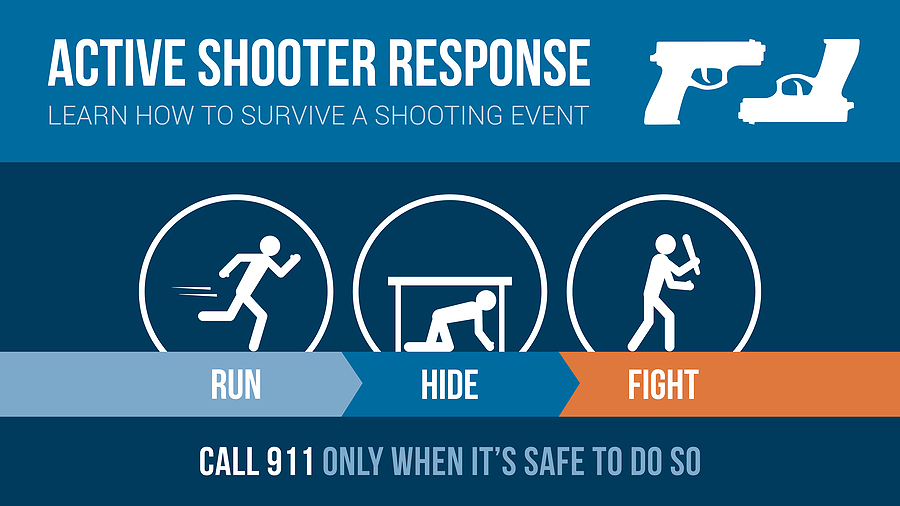What’s the Best Way to Deal with Active Shooter Risks in the Workplace?

Active shooter incidents are a sad fact of life, and employers have growing concerns on how such threat impacts their workplace.
An FBI report detailed that there is a dramatic increase in active shooter situations based on 2017-2021 statistics. Active shooter cases rose by nearly 53 percent from 2020 to 2021 and by nearly 98 percent since 2017.
These data underscore the importance of employers remaining vigilant about active shooter awareness and prevention. But getting ready in the event of an active shooter attack can be a daunting task for employers, and there are a number of hurdles that block a business from drawing up a plan of action. To successfully manage these obstacles, knowing the typical road blocks and best practices for developing and implementing an active shooter plan is key.
Active Shooter Challenge for Employers
Though corporations may recognize the necessity in preparing for an active shooter opportunity, many will not develop a plan. There can be any number of causes for this, but the more common include the following:
- The employer simply does not have the expertise, or resources, to design a workable active shooter plan
- The employer has other pressing needs that it must focus on in order for it to function on a daily basis
Organizations would hear about an active shooter in the news and start to work on a plan, but stall before they had written procedures in place. To remove this roadblock, companies need to prioritize preparing for an active shooter incident.
Active shooter events should be handled in similar fashion to other types of risk management issues.
Employers must show a commitment to protecting their business, employees, members, and clients from the dangers posed by acts of violence. Until then, businesses cannot move forward with an active shooter prevention plan in earnest.
Develop and adopt an active shooter plan
And much the same way that it’s unlikely you can eradicate the risk of an active shooter situation – and the trauma and possible litigation that can follow one – you can at least prepare your organization to know how to respond to threats that do become real. To help avoid expensive lawsuits and liabilities stemming from active shooter situations, organizations should consider the following best practices for establishing and executing a plan:
Leverage expertise
It’s a fact that most businesses won’t be equipped to have the expertise required for crafting an active shooter plan in-house. But employers have a number of outside sources to draw on that can help them come up with a plan that fits their operation.
Employers can ask the help of law enforcement officers, fire departments, trade groups and the Department of Homeland Security. These organizations have the information and observations that can help employers best prepare for an active shooter scenario.
For example, a business can have its local police department assist with drills that replicate an actual active shooter situation.
Customize the plan
Active shooter plans have similarities across various paths and it must fit the business. Ultimately, what works for a manufacturing company with many locations may not be relevant to a nonprofit or school dealing with a vulnerable population.
Companies should be conducting a full risk assessment and taking very close look at every aspect of their plan to make sure it addresses active shooter exposures that are specific to their operation.
Integrate the plan
When working through an active shooter plan employers should incorporate into business continuity plans, risk management plans, workplace violence prevention programs and zero-tolerance workplace violence policies. The latter two are the most important, considering:
- Workplace violence prevention programs – Written workplace violence prevention programs, as part of an overall safety and health program, are intended as a proactive way to reduce or eliminate the likelihood of violence in the workplace. A prevention program aims to provide guidance on developing workplace-appropriate policies to prevent and respond to violence. It should have specific goals for preventing workplace violence, be adapted to the size of the company and be easily adaptable for various specific situations.
- Zero-tolerance workplace violence policies – In most cases, the danger of imminent violence is avoidable in the workplace if the employer takes necessary precautions. There is no stronger shield an employer can provide employees from workplace violence than a stance of zero tolerance. That policy ought to carry an explicit guarantee to safeguard all workers against any type of violence in the workplace. It should also be a zero-tolerance policy, so breaking the rule once would be cause for termination.
Train employees
As vital as it is to have a written active shooter plan reflecting the policies and procedures your company has adopted, your employees also need active shooter training from time to time and active shooter drills conducted at the workplace periodically. These training programs and exercises serve to guide employees through the process so that they know what to do when something actually happens. Between drills and training, the more an employer offers, the better-trained its employees will be.
Active shooter training is valuable not only for in-office staff, but also for remote employees and field workers. That is because active shooter safety tenets (e.g., threat assessment) translate to on-site or off-site regardless.
Training and drill schedules should be regularly reviewed and modified for any organizational changes or policy updates, and for review of employee performance during past active-shooter drills. Once more, employers will have to consider at-risk populations as they design and refine these drills. This is critical to take into account when you take into account these populations (e.g., children, elderly, dementia /cognitively impaired or individuals with disabilities) may not be able to evacuate when an active shooter threat presents itself and will have different safety plans.
When screening these strategies, employers should understand that active shooter plans aren’t a one-size-fits-all proposition: They’re living documents, and employers need to be flexible in terms of how they can address their respective workplace and employee population. This enables businesses to practice their active shooter plans, and also to help those things they hold most important, their employees.
Key takeaways
- The number and frequency of mass shooting incidents has been rising in recent years
- Similar to other risk management issues, active shooter incidents must be treated.
- Developing a documented active shooter plan is important and will help to document your policies and procedures.
Take the next step
In Albuquerque, Safety Counselling can provide your business with Active Shooter Training. Call 505-881-1112 to enroll in its next Active Shooter Training.
